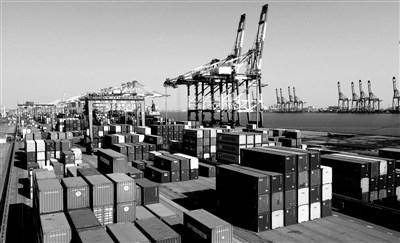
In addition to the rise in raw materials, the pressure brought by the appreciation of the renminbi and the high international shipping costs has not yet come to an end, Xinhua News Agency figured.
“Now it’s really troublesome!”
Cai Shaohua, general manager of Zhejiang Huajia Holding Group, did not achieve his wish. Originally, he expected that the exaggerated increase in raw materials could come down after March after the “good start.” rise”.
From the beginning of the construction in February, I was afraid to accept orders, and now I can’t resist the pressure and have to negotiate price increases with customers. Cai Shaohua uses “half stagnation” to describe the state of the recent months, “Although the customers understand the current situation. , But when it comes to price increases, communication will definitely take time.”
Bite the scalp to sign orders and ship products under pressure from a loss, what Cai Shaohua can do is to continuously increase inventory-on the one hand, the production capacity is minimized as much as possible, and on the other is the goods that are still negotiating price increases and are afraid to ship.
In the first quarter, foreign trade exports increased by nearly 40% year-on-year, and due to pressures such as the soaring of rare raw materials in recent years, such “half stagnation” has been forced to become the “new normal” for foreign trade manufacturing companies.
Inventory increased by 30% and the delivery cycle is 70 days longer
Since the beginning of this year, the prices of major products in the iron and steel, copper mining, petrochemical and other industries have continued the upward trend that started last year, and after setting a historic “good start”, they have not fallen as quickly as in previous years, but have continued to rise.
As an important raw material for industrial products, in less than a year, the price of London copper has risen from US$6,000/ton to more than US$9,000/ton, and Shanghai copper has also risen from more than 40,000 yuan/ton to nearly 70,000 yuan/ton. Nearly doubled.
As a Chinese wall-hung boiler manufacturer, Cai Shaohua’s main raw material is copper rods. The increase in copper prices has directly caused the company’s raw material costs to increase by nearly 50% this year.
The Mandarin Commodity Index rose to 182.49 on April 16, up 8.1% from January 29, of which the Industrial Product Index rose 10.2%. The increase of black varieties is particularly noticeable. The average settlement price of rebar futures in the first quarter reached 4,532 yuan/ton, an increase of 24.7% from the average price of the whole year in 2020, which was the highest level since the listing of rebar futures in 2009. The average settlement price of Shanghai iron ore futures reached 1062 yuan/ton, an increase of 39.7% from the average price of 2020.
“Raw materials have risen too much.” As an export manufacturer of electric bicycles, Zeng Xiansheng, general manager of Suzhou Mengshi Intelligent Vehicle Technology Co., Ltd. (hereinafter referred to as “Mengshi Intelligent”), told China Business News that the main material for electric bicycles is aluminum alloy. There are also motors, chips and rare earths. The prices of these materials have not only been high, but also often not available.
At present, the company’s orders have been scheduled until after June. Zeng Xiansheng, who “do not have to worry about orders”, has a headache because of the continuously delayed delivery cycle and the subsequent rising pressure on the capital chain.
“Now that raw materials are required to be paid in cash, the original billing period is gone. Many lithium batteries are prepaid and still not available.” Zeng Xiansheng said that in the past when raw materials were purchased, upstream companies would still give about 60 days of billing. , Now it’s the other way around, and if you give money, you have to wait in line for the goods. “There is a transmission that is even scheduled to 2023.”
The delivery cycle on the other end is also extending. Zeng Xiansheng’s delivery cycle is about 70 days longer than before. As far as Cai Shaohua is concerned, on the basis of increasing inventory by 30%, it is still unknown how much the delivery cycle will be extended.
While being forced to negotiate price increases and indefinitely extended delivery, companies also face the risk of loss of orders or decline in sales.
The direct consequence of being squeezed by both ends is that the pressure on the corporate capital chain has increased significantly, which in turn triggers a wave of corporate failures in a vicious circle.
CCTV’s previous survey of the manufacturing industry in Guangdong showed that some small household appliances companies that were unable to mold and process electrical accessories on their own went bankrupt when they were unable to withstand the price increase of general parts factories and were unable to receive orders in the short term.
Cai Shaohua is looking forward to the time node of May 1st, “March to May of each year is the off-season. We are still holding on to the wait and see. Let’s raise prices after May 1st.”
In fact, it is not only domestic small and medium-sized enterprises that are under pressure, but even international industry giants can’t help but raise prices one after another.
Recently, American body care and cleaning products giants Procter & Gamble and Coca-Cola have announced price increases, which has aroused the attention of the consumer market.
“This is the largest increase in commodity raw materials in my 33 years at P&G. This momentum may still exist for a long time.” P&G Chief Operating Officer Jon Moller said that this made him have to Announced an increase in the prices of daily necessities, from diapers to toilet paper, starting in September of this year.
The Coca-Cola Company also said that it cannot withstand the pressure of rising raw material prices, and the company has made a decision to increase product prices.
RMB enters the 6.4 era
In addition to the rise in raw materials, the pressure brought by the appreciation of the renminbi and high international shipping costs has not yet come to an end.
“If this continues, foreign trade people don’t want to do it anymore.” Li Qi, the person in charge of a garment foreign trade manufacturing company in the Yangtze River Delta, told China Business News that the pressure on foreign trade companies from the appreciation of the renminbi is not less than the impact of rising raw materials.
Since the beginning of the appreciation trend in the second half of last year, the renminbi has risen by nearly 10%. This is also the biggest and strongest rise in the impression of Li Qi, who has been in foreign trade for more than 20 years.
On April 22, the China Foreign Exchange Trading Center announced data that the central parity of the RMB against the US dollar was reported at 6.4902, an increase of 144 basis points.
Wang Tao, chief China economist at UBS, believes that the US dollar-renminbi exchange rate is expected to be around 6.4 at the end of this year, and may fluctuate widely driven by the exchange rate trend of the US dollar against major currencies. This also means that the renminbi is already in the 6.4 era.
Li Qi, who pays close attention to exchange rate fluctuations, believes that the renminbi will continue to appreciate. “One day in February, the offshore renminbi broke through 6.4 at some point and reached 6.39. Although it is not a long time, it may rise to 6.3 this year. Provided support”.
Compared with the end of last year, the tight situation of container transportation has eased slightly, but the freight rate is still at a high level, and the capacity arrangement is nearly a month and a half earlier than before.
Zhou Shihao, CEO of China’s one-stop international logistics service platform “Where to ship”, told CBN that in the past, orders for late May would not be arranged until May 15, but now the transportation plan for May has been arranged, “90 % Of the capacity has been arranged, and we will start to arrange the capacity for June next week.”
According to his observation, at present, whether it is shipping or air transport, or the China-Europe express train, it is already at the limit level. Due to tight shipping capacity and high freight rates, companies are beginning to need more digital information to combat anxiety and uncertainty.
Catalyzed by the epidemic, digitalization and e-commerce have also become high-frequency words in the field of foreign trade.
In the first quarter of this year, China’s foreign trade maintained a recovery growth. According to data from the General Administration of Customs, my country’s exports in the first quarter were 4.6 trillion yuan, a year-on-year increase of 38.7%. As an emerging trade format, cross-border e-commerce continued its good development trend last year, with exports increasing by 69.3% year-on-year, becoming one of the main forces for stable growth in foreign trade.
On April 22, Alibaba International Station announced the trend of foreign trade in 2021 and its digital overseas strategy. Zhang Kuo, vice president of Alibaba Group and general manager of Alibaba International Station, said that during the epidemic, the penetration rate of global e-commerce has increased significantly, and the trend of online procurement is irreversible. As the structural position of China’s supply in the world continues to increase, the dividends of cross-border e-commerce overseas are still there. It is a new opportunity for Chinese manufacturing to go overseas with high quality through branding.
Zhang Kuo told China Business News that in the global trade chain, raw material price increases and RMB appreciation and other costs transfer mainly depend on which party is stronger and which party has the right to speak. China’s manufacturing has the largest supporting role in the world, and it is especially irreplaceable during the epidemic. Therefore, from the data on the platform, we have not yet seen a significant price increase trend and market resistance to price increases, but it should be emphasized that Chinese manufacturing companies must seize the window period of the epidemic and gradually move from scale growth to quality increase.
The general manager of Huasheng Shuanglang (Beijing) Textile Co., Ltd., which develops antibacterial and deodorant textile fabrics, has made a wish and has been operating cross-border e-commerce business for more than 10 years. She told China Business News that the price increase of raw materials and the appreciation of the renminbi are likely to become the norm for a long time. Their response to rising raw material prices is to provide customers with more alternative fabric solutions out of a full understanding of raw materials.
Xu Xinxian said that they will now lock in the RMB price with their customers in the contract to avoid losses caused by the appreciation of the RMB as much as possible. With the help of platforms such as Alibaba International Station, they will also increase added value and efficiency by strengthening brand building, using a series of programs such as overseas warehouses, rapid foreign exchange settlement, and business loans.





























































You must log in to post a comment.